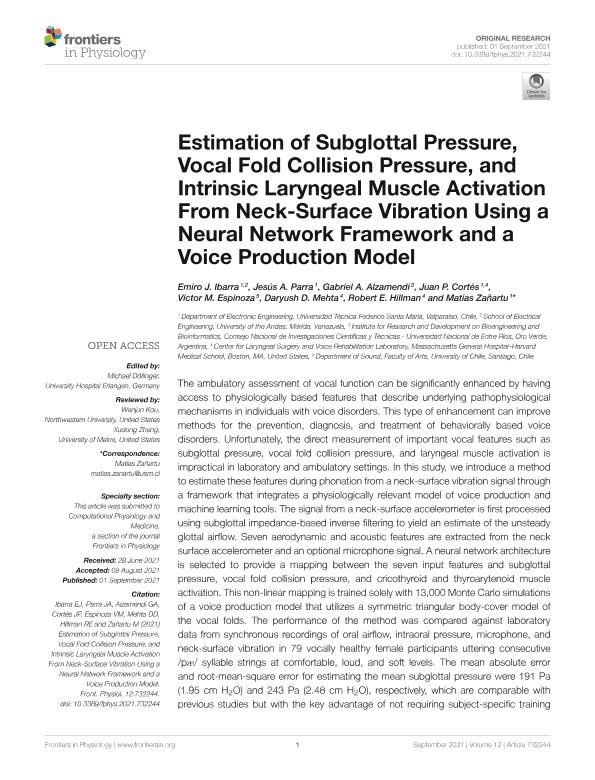Mostrar el registro sencillo del ítem
dc.contributor.author
Ibarra, Emiro J.
dc.contributor.author
Parra, Jesús A.
dc.contributor.author
Alzamendi, Gabriel Alejandro

dc.contributor.author
Cortés, Juan P.
dc.contributor.author
Espinoza, Víctor M.
dc.contributor.author
Mehta, Daryush D.
dc.contributor.author
Hillman, Robert E.
dc.contributor.author
Zañartu, Matías
dc.date.available
2022-10-17T12:29:58Z
dc.date.issued
2021-09
dc.identifier.citation
Ibarra, Emiro J.; Parra, Jesús A.; Alzamendi, Gabriel Alejandro; Cortés, Juan P.; Espinoza, Víctor M.; et al.; Estimation of Subglottal Pressure, Vocal Fold Collision Pressure, and Intrinsic Laryngeal Muscle Activation From Neck-Surface Vibration Using a Neural Network Framework and a Voice Production Model; Frontiers Media; Frontiers in Physiology; 12; 9-2021; 1-13
dc.identifier.issn
1664-042X
dc.identifier.uri
http://hdl.handle.net/11336/173425
dc.description.abstract
The ambulatory assessment of vocal function can be significantly enhanced by having access to physiologically based features that describe underlying pathophysiological mechanisms in individuals with voice disorders. This type of enhancement can improve methods for the prevention, diagnosis, and treatment of behaviorally based voice disorders. Unfortunately, the direct measurement of important vocal features such as subglottal pressure, vocal fold collision pressure, and laryngeal muscle activation is impractical in laboratory and ambulatory settings. In this study, we introduce a method to estimate these features during phonation from a neck-surface vibration signal through a framework that integrates a physiologically relevant model of voice production and machine learning tools. The signal from a neck-surface accelerometer is first processed using subglottal impedance-based inverse filtering to yield an estimate of the unsteady glottal airflow. Seven aerodynamic and acoustic features are extracted from the neck surface accelerometer and an optional microphone signal. A neural network architecture is selected to provide a mapping between the seven input features and subglottal pressure, vocal fold collision pressure, and cricothyroid and thyroarytenoid muscle activation. This non-linear mapping is trained solely with 13,000 Monte Carlo simulations of a voice production model that utilizes a symmetric triangular body-cover model of the vocal folds. The performance of the method was compared against laboratory data from synchronous recordings of oral airflow, intraoral pressure, microphone, and neck-surface vibration in 79 vocally healthy female participants uttering consecutive /pæ/ syllable strings at comfortable, loud, and soft levels. The mean absolute error and root-mean-square error for estimating the mean subglottal pressure were 191 Pa (1.95 cm H2O) and 243 Pa (2.48 cm H2O), respectively, which are comparable with previous studies but with the key advantage of not requiring subject-specific training and yielding more output measures. The validation of vocal fold collision pressure and laryngeal muscle activation was performed with synthetic values as reference. These initial results provide valuable insight for further vocal fold model refinement and constitute a proof of concept that the proposed machine learning method is a feasible option for providing physiologically relevant measures for laboratory and ambulatory assessment of vocal function.
dc.format
application/pdf
dc.language.iso
eng
dc.publisher
Frontiers Media

dc.rights
info:eu-repo/semantics/openAccess
dc.rights.uri
https://creativecommons.org/licenses/by/2.5/ar/
dc.subject
AMBULATORY MONITORING
dc.subject
CLINICAL VOICE ASSESSMENT
dc.subject
NECK-SURFACE ACCELEROMETER
dc.subject
NEURAL NETWORKS
dc.subject
SUBGLOTTAL PRESSURE ESTIMATION
dc.subject
VOICE PRODUCTION MODEL
dc.subject.classification
Otras Ciencias de la Computación e Información

dc.subject.classification
Ciencias de la Computación e Información

dc.subject.classification
CIENCIAS NATURALES Y EXACTAS

dc.title
Estimation of Subglottal Pressure, Vocal Fold Collision Pressure, and Intrinsic Laryngeal Muscle Activation From Neck-Surface Vibration Using a Neural Network Framework and a Voice Production Model
dc.type
info:eu-repo/semantics/article
dc.type
info:ar-repo/semantics/artículo
dc.type
info:eu-repo/semantics/publishedVersion
dc.date.updated
2022-09-14T14:12:13Z
dc.journal.volume
12
dc.journal.pagination
1-13
dc.journal.pais
Suiza

dc.journal.ciudad
Lausanne
dc.description.fil
Fil: Ibarra, Emiro J.. Universidad Tecnica Federico Santa Maria.; Chile
dc.description.fil
Fil: Parra, Jesús A.. Universidad Tecnica Federico Santa Maria.; Chile
dc.description.fil
Fil: Alzamendi, Gabriel Alejandro. Universidad Nacional de Entre Ríos. Instituto de Investigación y Desarrollo en Bioingeniería y Bioinformática - Consejo Nacional de Investigaciones Científicas y Técnicas. Centro Científico Tecnológico Conicet - Santa Fe. Instituto de Investigación y Desarrollo en Bioingeniería y Bioinformática; Argentina
dc.description.fil
Fil: Cortés, Juan P.. Universidad Tecnica Federico Santa Maria.; Chile
dc.description.fil
Fil: Espinoza, Víctor M.. Universidad de Chile; Chile
dc.description.fil
Fil: Mehta, Daryush D.. Center For Laryngeal Surgery And Voice Rehabilitation; Estados Unidos
dc.description.fil
Fil: Hillman, Robert E.. Center For Laryngeal Surgery And Voice Rehabilitation; Estados Unidos
dc.description.fil
Fil: Zañartu, Matías. Universidad Tecnica Federico Santa Maria.; Chile
dc.journal.title
Frontiers in Physiology
dc.relation.alternativeid
info:eu-repo/semantics/altIdentifier/url/https://www.frontiersin.org/articles/10.3389/fphys.2021.732244/full
dc.relation.alternativeid
info:eu-repo/semantics/altIdentifier/doi/http://dx.doi.org/10.3389/fphys.2021.732244
Archivos asociados
